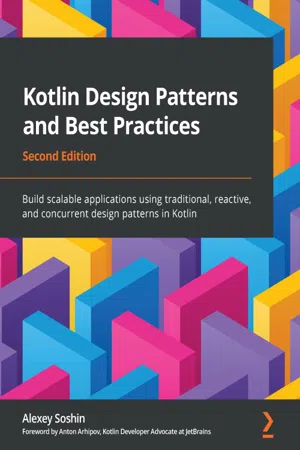
Kotlin Design Patterns and Best Practices
Alexey Soshin, Anton Arhipov
- 356 pagine
- English
- ePUB (disponibile sull'app)
- Disponibile su iOS e Android
Kotlin Design Patterns and Best Practices
Alexey Soshin, Anton Arhipov
Informazioni sul libro
Future-proof your applications with best practices and design patterns in KotlinKey Features• Understand traditional and modern design patterns to improve the design of your application• Combine the benefits of object-oriented, functional, reactive, and concurrent programming• Choose the best microservices architecture and frameworks for your web applicationBook DescriptionThis book shows you how easy it can be to implement traditional design patterns in the modern multi-paradigm Kotlin programming language, and takes you through the new patterns and paradigms that have emerged. This second edition is updated to cover the changes introduced from Kotlin 1.2 up to 1.5 and focuses more on the idiomatic usage of coroutines, which have become a stable language feature. You'll begin by learning about the practical aspects of smarter coding in Kotlin, as well as understanding basic Kotlin syntax and the impact of design patterns on your code. The book also provides an in-depth explanation of the classical design patterns, such as Creational, Structural, and Behavioral families, before moving on to functional programming. You'll go through reactive and concurrent patterns, and finally, get to grips with coroutines and structured concurrency to write performant, extensible, and maintainable code. By the end of this Kotlin book, you'll have explored the latest trends in architecture and design patterns for microservices. You'll also understand the tradeoffs when choosing between different architectures and make informed decisions. What you will learn• Implement all the classical design patterns using the Kotlin programming language• Apply reactive and concurrent design patterns to make your application more scalable• Discover best practices in Kotlin and explore its new features• Understand the key principles of functional programming and learn how they apply to Kotlin• Find out how to write idiomatic Kotlin code and learn which patterns to avoid• Harness the power of Kotlin to design concurrent and reliable systems with ease• Create an effective microservice with Kotlin and the Ktor frameworkWho this book is forThis book is for developers who want to apply design patterns they've learned from other languages in Kotlin and build reliable, scalable, and maintainable applications. You'll need a good grasp on at least one programming language before you get started with this book. Java or design patterns will be particularly useful, but you'll still be able to follow along if you code in other languages.
Domande frequenti
Informazioni
Section 1: Classical Patterns
- Chapter 1, Getting Started with Kotlin
- Chapter 2, Working with Creational Patterns
- Chapter 3, Understanding Structural Patterns
- Chapter 4, Getting Familiar with Behavioral Patterns
Chapter 1: Getting Started with Kotlin
- Basic language syntax and features
- Understanding Kotlin code structure
- Type system and null safety
- Reviewing Kotlin data structures
- Control flow
- Working with text and loops
- Classes and inheritance
- Extension functions
- Introduction to design patterns
Technical requirements
- IntelliJ IDEA Community Edition (https://www.jetbrains.com/idea/download/)
- OpenJDK 11 or higher (https://openjdk.java.net/install/)
Basic language syntax and features
- Pragmatic: Makes things we do often easy to achieve
- Readable: Keeps a balance between conciseness and clarity on what the code does
- Easy to reuse: Supports adapting code to different situations
- Safe: Makes it hard to write code that crashes
- Interoperable: Allows the use of existing libraries and frameworks